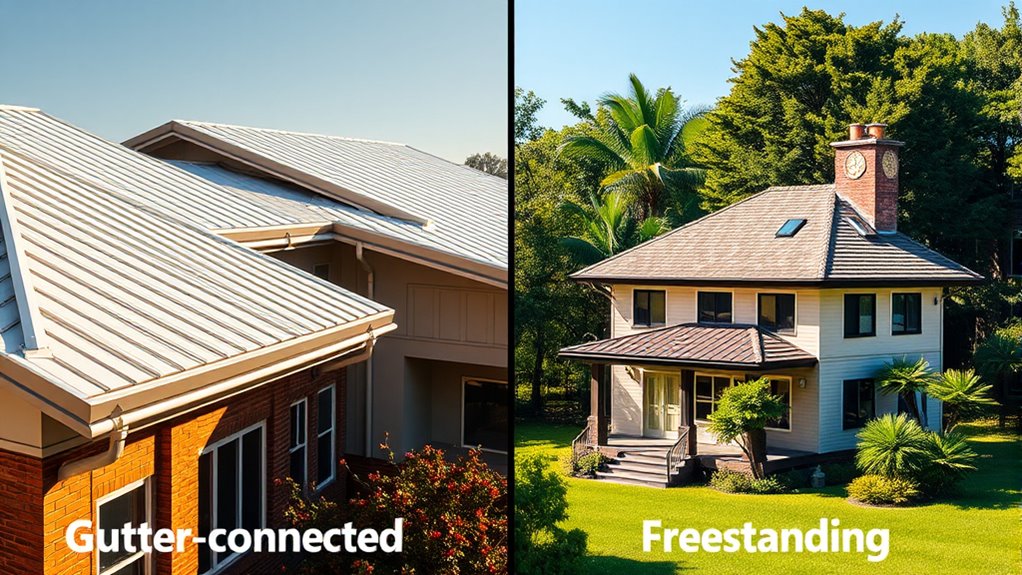Gutter-connected and freestanding greenhouse designs each have their benefits. Gutter-connected structures offer a cohesive look, easier rainwater harvesting, and energy efficiency but limit flexibility for expansion or reconfiguration. Freestanding greenhouses provide greater customization, versatile layouts, and independence, making them ideal if you want to expand or change your garden over time. Understanding these differences helps you choose the best option for your needs—keep exploring to discover which design suits your garden goals best.
Key Takeaways
- Gutter-connected greenhouses facilitate rainwater harvesting and create a uniform aesthetic, while freestanding greenhouses offer greater design flexibility.
- Connected structures are more energy-efficient and easier to maintain collectively, whereas freestanding units allow independent expansion and customization.
- Gutter-connected designs promote a streamlined, cohesive appearance in gardens, whereas freestanding greenhouses support diverse layouts and focal points.
- Connected greenhouses limit layout modifications and scalability, but simplify watering systems; freestanding options adapt better to evolving needs.
- Gutter-connected models integrate seamlessly with existing structures, enhancing aesthetics and sustainability; freestanding models provide versatile, standalone options.

Are you trying to decide between gutter-connected and freestanding greenhouse designs? Both options have their advantages, but understanding how they differ can help you choose the best fit for your gardening needs. One key factor to weigh is rainwater harvesting. Gutter-connected greenhouses often feature shared roof structures, making it easier to install rainwater collection systems. This setup allows you to efficiently harvest rainwater, which can be used for watering your plants, reducing your reliance on municipal water sources, and promoting sustainability. If water conservation is a priority, a gutter-connected design simplifies the collection process, as the continuous roofline channels water into shared gutters and storage tanks. Conversely, freestanding greenhouses typically require separate rainwater harvesting systems for each structure, which might increase complexity and cost but offers flexibility in placement and scalability.
Another important aspect to evaluate is aesthetic appeal. Gutter-connected greenhouses tend to have a more cohesive and streamlined appearance because they form a continuous structure. This can create a more professional and polished look in your garden or property, especially if you’re aiming for a uniform landscape design. Their connected rooflines and shared walls can blend seamlessly with existing structures, enhancing the overall visual harmony. On the other hand, freestanding greenhouses offer a more versatile and customizable aesthetic. You can choose different styles, colors, and materials for each unit, allowing you to create a unique garden layout or focal points. Freestanding designs also give you the option to position each greenhouse independently, which can be useful if you want to optimize sunlight exposure or create separate microclimates for different plant types.
Beyond appearance, the decision also impacts practical aspects like maintenance and expansion. Gutter-connected greenhouses usually require coordinated maintenance of shared gutters and roofing, but they can be easier to manage in terms of watering systems due to the unified rainwater harvesting setup. They also tend to be more efficient in terms of energy use, as heat can transfer more easily between connected structures. Freestanding greenhouses, by contrast, provide greater flexibility for expansion or rearranging your garden layout over time. You can add new units or relocate existing ones without affecting adjacent greenhouses. This modular approach can suit your evolving garden plans and allow you to customize each space according to specific needs.
Frequently Asked Questions
How Do Maintenance Costs Compare Between Gutter-Connected and Freestanding Designs?
You’ll find that gutter-connected designs tend to be more cost-efficient over time due to lower repair frequency, as their integrated structure offers better protection against weather and wear. Freestanding designs might require more frequent repairs, increasing maintenance costs. While initial expenses may differ, gutter-connected options typically save you money in the long run with less upkeep needed, making them a smarter choice for reducing ongoing maintenance costs.
Are There Specific Architectural Styles Better Suited for One Design?
Like a puzzle fitting perfectly, certain architectural styles align better with specific designs. For example, traditional styles often suit gutter-connected structures, blending seamlessly with their cohesive look. Modern or minimalist styles, on the other hand, pair well with freestanding designs, offering clean lines and flexibility. Your choice depends on design compatibility, ensuring the building’s aesthetic harmony. So, consider your architectural style carefully to enhance overall visual appeal and functionality.
What Are the Typical Lifespan Differences Between the Two Structures?
You’ll find that gutter-connected structures often have a longer lifespan due to better material durability and enhanced structural integrity, as they share walls and foundations. Freestanding designs, however, may face more wear and tear over time because their isolated structures are more exposed to weather and shifting soil. Regular maintenance can extend both types’ lifespans, but overall, gutter-connected options tend to last longer if built with quality materials.
How Does Climate Influence the Choice of Design?
You choose your structure based on climate adaptability and material durability. In harsh, wet environments, gutter-connected designs often handle rain better, while in extreme cold, freestanding structures resist snow buildup. You consider wind resistance in storm-prone areas and UV protection where sunlight is intense. By matching design to climate factors, you guarantee your building withstands weather challenges, extending its lifespan and maintaining safety and functionality.
Can These Designs Be Easily Modified or Expanded Later?
You can typically modify or expand gutter-connected and freestanding designs, but their modifiability and flexibility vary. Gutter-connected structures often have better expansion potential since you can add sections seamlessly. Freestanding designs offer more flexibility for future changes but might require significant adjustments when expanding. To guarantee your project adapts easily, choose a design with high expansion potential and plan for adaptable features from the start.
Conclusion
Ultimately, choosing between gutter-connected and freestanding designs is like selecting the right pair of shoes — each has its own rhythm and purpose. Gutter-connected systems flow seamlessly like a well-rehearsed dance, while freestanding units stand tall like independent stars. Consider your space and needs; whichever path you choose, make sure it fits like a glove. After all, the right design will be the sturdy backbone of your home’s harmony, standing strong against the elements.










